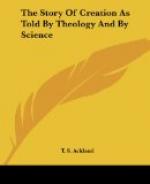On a clear evening in the early spring months, as soon as twilight is completely ended, a conical streak of light may be sometimes seen, arising’ from the western horizon, and extending through an arc of 60 or 70 degrees, nearly in the direction of the Ecliptic, and finally terminating in a point. This is the Zodiacal light. In tropical climates it is seen much more frequently, [Footnote: Humboldt, Kosmos, vol. i. p. 126 (Bohu’s edition).] and is much more brilliant than in England. This then is probably an envelope of still fainter light than the corona. It must extend beyond the orbit of Venus, as the maximum elongation of Venus is 47 degrees, while the Zodiacal light has been traced for 70 degrees, and probably farther. It is very possible that the earth is occasionally involved in it, and that from it we derive that diffused light which, though faint, is very serviceable to us on a starless evening, and of which no other account has as yet been given. The light we receive in this way is often as powerful as that which we should receive from the stars if they were not hidden by clouds.
These phenomena seem to point to the conclusion that the condensation of light in the sun has been a very gradual process, which is even yet incomplete. If we suppose that at the time of the formation of the coal measures it was not far advanced, but that a diffused light extended beyond the orbit of the earth, similar in some respects to the present Zodiacal light, but equal in intensity to the light which we now see in the corona, the phenomena of the third day will be satisfactorily accounted for. There is, however, still an enormous amount of mystery connected with the sun. It is the centre from which an inconceivable amount of force in the shape of light, heat, actinism, and probably other manifestations, is hourly poured forth. If the whole of that force were divided




